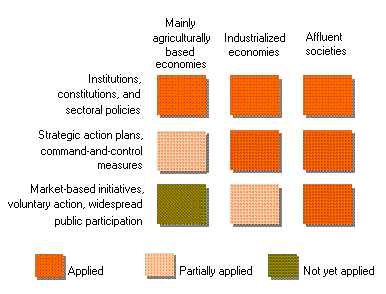|
|
|

Overview of Regional Policy ResponsesChapter 3 summarizes policy responses to environmental issues in different regions; it indicates that typically these responses focus first on institutional and constitutional issues, and then on the implementation and enforcement of often disjointed sectoral environmental legislation and regulations. Subsequent actions concentrate on developing comprehensive strategic and integrated plans for the protection of the environment, such as National Environmental Action Plans, and an array of concerted command-and-control measures. Later, attention is given to introducing market-based incentives research, creating conducive environments for voluntary, flexible, and innovative actions, and stimulating increased participation and commitment by all sectors of society. Figure 4 illustrates this pattern in policy responses.
 Figure 4. Changing use of policy instruments over time. Progression through the cascade of policy responses is often constrained in developing regions by weak institutions, insufficient human and financial resources, ineffective legislation, and a lack of compliance monitoring and enforcement capabilities. In other instances, environmental institutions and regulations have been introduced at the request of external forces, such as international conventions and strategies, donor requirements, and structural adjustment programmes, and are only later internalized by countries. In the more developed regions of the world, experience with environmental management and conservation is extensive and of longer duration. Adequate safeguards in the initial stages were largely achieved through Government-regulated command-and-control policies. Effective implementation of such policies relied on legislation and measures such as emission standards and limits as well as on maximum permitted rates of resource use. Today, countries are increasingly using a mix of command-and-control policies and market-based incentives to achieve cleaner and more resource-efficient production systems and to modify consumers' attitudes. More integrated approaches that rely on cleaner production processes rather than on end-of-pipe solutions and accounting on a cradle-to-grave basis are being tested in a number of countries, addressing the industrial, agricultural, forestry, transportation, and fishery sectors. These measures have not yet been used to their full potential anywhere. Although there is repeated acknowledgement of both the "vicious cycle of poverty" and its intrinsic linkages with the environment and the urgency to address poverty alleviation, little evidence emerged from the regional reports that effective and concerted actions have been taken since Rio to ensure that environmental policies benefit the poorest members of society. Only anecdotal evidence suggests striking individual and community solutions, as in income-generating initiatives recounted at the UNEP Global Assembly of Women and the Environment in 1992. A vacuum still remains at the national level for linking environmental protection to social investment, such as education, better health care, and employment generation for the poor, especially women. Empowerment of communities and the growth of environment-oriented NGOs in civil society are increasingly recognized in all regions as powerful mechanisms to advance sustainable development. However, real participation and commitment to the environmental cause by civil society often follows clear Government action in the implementation of environmental policies. In regions where such governmental policies are weak and ineffective, public participation and empowerment are generally low. Despite the contradicting tendencies described above, a heartening sign is the tendency to strengthen regional and subregional co-operation world-wide. This might well prove to be one of the most powerful mechanisms to move national and global institutions forward towards sustainable development. Table 3 depicts environmental regional policy responses and their relative importance within and across regions.

| |
Executive Summary |




